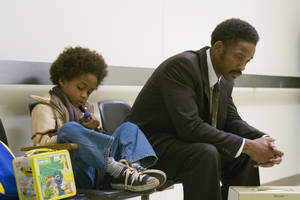Can a man face a plethora of hardships both personally and professionally to pursue a bit of happiness, especially when the only happiness he knows of is the word “happyness” written on a wall? The answer would be this movie, which is based on a true story written by Steven Conrad and is directed by Gabriele Muccino. This movie was an immediate success with audiences and has been critically acclaimed as “an inspirational and often emotionally wrenching story.”[1]
The story is set in the 1980s with an African American protagonist, Chris Gardner (Will Smith), who was the top of his class in the Navy yet was on the verge of bankruptcy. He invests all of his life savings in a portable bone density scanner, which provides slightly denser pictures than X-rays for twice the money. Chris’s belief in the product showing potential leads him to gamble his family’s entire life savings, which destroys his family as his wife Linda (Thandie Newton) leaves him and their five-year-old son Christopher (Jaden Smith) and moves to New York to start a new life. Chris soon realizes that there is little demand for the portable bone density scanner, rendering his stock in the company worthless.
Without money or a life partner, Chris finds it challenging to work his way from a six-month unpaid internship with a brokerage firm called Dean Witter to a single spot that twenty men are vying for. After taking the internship, Chris’s real income changes once he leaves his job as a salesman; it doesn’t help that $600 is taken from his account by the government because of his inability to pay his bills. Chris is then forced to move out from his house and live in a rented apartment. There is a decrease in Chris’s purchasing power. Christopher no longer attends day care as Chris cannot afford it. At one point during the movie, Chris even sells his blood to earn $21 as he only has around $8 to his name. When Chris has no money at all, he and Christopher live at a homeless shelter and even in a subway station bathroom. But the problem with homeless shelters is that there are too many people who are homeless and the rooms provided are not enough for everyone. That is why there is a queue outside the shelters every day starting at 5 P.M. Not many people can afford a home so the government devises a policy to make homeless shelters where people can live for free. But there is excess demand for these, which the shelters cannot accommodate; so space is given on a first-come, first-served basis.
One particularly memorable scene is staged in the subway, when Chris tries to bring to life Christopher’s imagination of them traveling through time via the bone density scanner. This is an important part of the movie as the mise-en-scene has been shown to represent the struggles faced by Chris and his efforts to achieve happiness. The melancholic music suddenly changes and the reality of the situation seeps in as the music becomes heavy. This scene lets the viewers marvel at the atmosphere Chris creates for his son and the sudden change in atmosphere when they lock themselves inside a toilet and have to spend the entire night there as they have no other place to sleep.
In this scene we can witness the desperation of Chris to find shelter as we see them living in a bathroom, a place which is perceived as a dirty place where people prefer not to live. The luggage beside them while sleeping depicts the “baggage,” their mistakes and problems that they have to carry around with them. The scene shows a timeline in which the left side shows the “baggage” they carry around with them; the center shows the present state they are in, lying on toilet paper, which shows how worthless and miserable their life is; and the right side shows the hope and happiness that they strive to achieve.
The movie was a hit in the theaters and it received a total of 34 award nominations and has won 12 awards including a nomination for an Oscar.[ii] This movie is such an inspiration that Washington D.C. officials took a group of homeless people to a screening of the movie, hoping that they would also aspire and work hard like Chris Gardner to pursue “happyness.”[iii] This movie is a stereotype breaker that sends a message to everyone that individuals aren’t rewarded via pity but through hard work, initiative, and sacrifice.[iv] Chris never shows the slightest bit of resentment or shame when he, as the only African American intern, is always asked to go get coffee or park a car. When he achieves his goal through sheer hard work and determination, everyone knows that he was the one who deserved the spot. There is no greed inside of Chris that made him want to change professions, it is the determination to provide for his son and himself that makes him pursue a new career and in the end attain the goal of “happyness.”[v]
[1] Manohla Dargis, “Climbing Out of the Gutter with a 5-Year-Old in Tow,” The New York Times, Dec. 15, 2006, http://www.nytimes.com/2006/12/15/movies/15happ.html?_r=0.
[ii]“The Pursuit of Happyness,” IMDb, http://www.imdb.com/title/tt0454921/?ref_=ttpl_pl_tt.
[iii] Sue Anne Pressley Montes, “A Chance for City’s Homeless to Pursue ‘Happyness,’” The Washington Post, Jan. 6, 2007, http://www.washingtonpost.com/wp-dyn/content/article/2007/01/25/AR2007012501927.html.
[iv] iMonk, “Recommendation and Review: The Pursuit of Happyness,” Internet Monk, Dec. 22, 2006, http://www.internetmonk.com/archive/recommendation-and-review-the-pursuit-of-happyness.
[v] “Synopsis for The Pursuit of Happyness,” IMDb, http://www.imdb.com/title/tt0454921/synopsis.
Author Biography
Harsh Mahaseth is currently pursuing his Bachelor’s degree in law from the National Academy of Legal Studies And Research, Hyderabad. His interest lies in linking legal and economic aspects to various literary pieces to get a more holistic understanding of it.
Film Details
Pursuit of Happyness (2006)
USA
Director Gabriele Muccino
Runtime 117 minutes










































